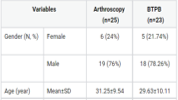Abstract
Bone-Patellar Tendon-Bone autograft (BPTB) and four-strand semitendinosus-gracilis (hamstring) graft are the most common methods used for reconstructing anterior cruciate ligament (ACL) but there is still controversy over the best method. This study aimed to compare the therapeutic outcomes of two methods of BPTB and hamstring grafts using arthroscopic treatment in patients with ACL rupture. The patients underwent ACL reconstruction surgery, either by bone-patellar tendon-bone autograft (BPTB) (open surgery) (n=23) or four-strand hamstring autograft (semitendinosus-gracilis) (by arthroscopy) (n=25). Lysholm score was used for knee functional status assessment, Lachman test for tendon laxity, and pivot shift test for strength evaluation. The 36-Item Short-Form Health Survey questionnaire (SF-36) was also completed and compared at the last follow-up. Patients were evaluated by type of daily heavy or light activities. Two groups showed no significant difference in the Lysholm score (P>0.05) and both groups were classified as “Good”. There was no significant difference between the frequency distribution of patients based on the Lachman test and pivot shift scores (P>0.05). None of the patients in the two groups had any rupture within two years after treatment. Both groups had good satisfaction with treatment and quality of life and there was no statistically significant difference between the mean SF-36 scores (P>0.05). Although complication in short-term follow-up was more in patients undergoing open surgery, the functional level and treatment satisfaction in patients treated by open surgery and arthroscopy were not significantly different after two years.
Full text article
Authors

This work is licensed under a Creative Commons Attribution-NonCommercial-NoDerivatives 4.0 International License.

